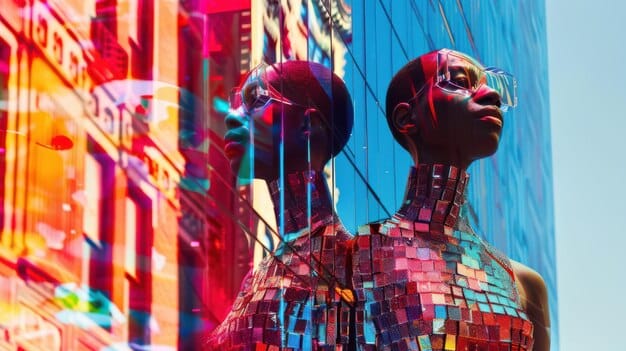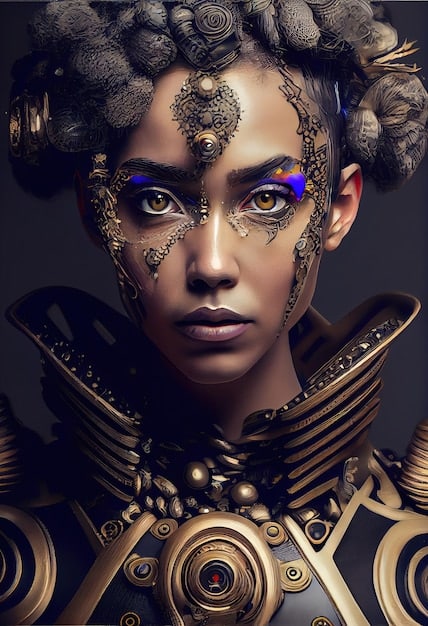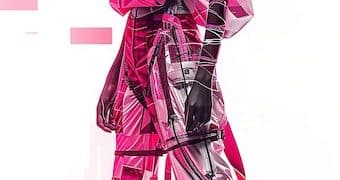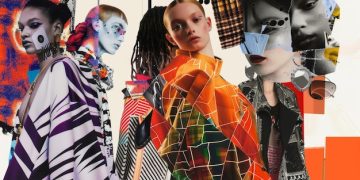Afrofuturism in the US: Race, Tech, and Imagination in 2025

Afrofuturism in the US is projected to flourish by 2025, intertwining African diaspora culture with technology and speculative fiction to envision progressive futures, challenge racial narratives, and foster innovation in art, music, literature, and activism.
In 2025, Afrofuturism in the US continues to evolve, offering a powerful lens through which to examine the intersection of race, technology, and imagination.
Understanding Afrofuturism: A 2025 Definition
Afrofuturism, by 2025, remains a vital and evolving cultural aesthetic. It combines elements of science fiction, fantasy, historical fiction, and Afrocentricity.
It explores the Black experience and connects the past with possible futures. Here’s a quick look at what defines Afrofuturism:
Key Elements of Afrofuturism
Afrofuturism uses a mix of themes and characteristics to convey its message.
- Technology and Innovation: Often features advanced technologies and scientific innovations that are accessible and beneficial to all, especially marginalized communities.
- Black Identity and Culture: Celebrates Black culture, history, and identity, providing a platform for self-expression and reclaiming narratives.
- Social Justice and Liberation: Addresses issues of racial inequality, oppression, and social injustice, advocating for a more equitable and inclusive future.
- Speculative Storytelling: Employs speculative fiction to imagine alternative realities and futures where Black people thrive and shape their own destinies.
In 2025, Afrofuturism is not just an artistic movement; it’s a powerful tool for social commentary and change. It inspires creativity, promotes inclusivity, and empowers marginalized communities.

The Roots of Afrofuturism in the US
Understanding the historical roots of Afrofuturism is crucial for appreciating its contemporary relevance.
It grew out of a need to reclaim and reimagine Black narratives.
Early Influences and Pioneers
The seeds of Afrofuturism were sown long before the term was coined.
- W.E.B. Du Bois: His writings explored themes of double consciousness and the Black experience, laying philosophical groundwork for Afrofuturism.
- Sun Ra: A jazz musician who blended ancient Egyptian mythology, science fiction, and avant-garde music to create a unique Afrofuturist persona.
- Octavia Butler: A science fiction writer whose novels like “Kindred” and “Parable of the Sower” tackled issues of race, gender, and power.
These pioneers used art, literature, and music to challenge prevailing narratives and envision alternative futures. Their work paved the way for subsequent generations of Afrofuturist artists and thinkers.
Understanding these early influences helps appreciate the full scope and depth of the movement. These roots continue to nourish and inspire contemporary artists and activists.
Afrofuturism in Art and Literature in 2025
By 2025, Afrofuturism has deeply influenced various artistic and literary forms. Artists and writers use Afrofuturism to explore themes of identity, culture, and social justice.
The impact on the landscape is widespread. Here’s how it’s shaping different fields:
Visual Arts
Afrofuturist visual art blends traditional African aesthetics with futuristic elements.
Artists are exploring new mediums and technologies to convey their visions:
- Digital Art: Artists use digital tools to create otherworldly landscapes, portraits, and abstract compositions.
- Sculpture: Sculptors combine traditional materials like wood and metal with futuristic elements like LED lights and microchips.
- Fashion: Designers create clothing that blends African textiles with high-tech fabrics and accessories, showcasing cultural pride and innovation.
Literary Works
Afrofuturist literature challenges conventional narratives and imagines alternative realities.
Authors are telling stories that explore themes of identity, diaspora, and liberation:
- Science Fiction Novels: Writers create complex worlds where Black characters shape their own destinies.
- Poetry: Poets use vivid imagery and rhythmic language to explore themes of race, technology, and spirituality.
- Graphic Novels: Illustrators and writers collaborate to create visually stunning stories that blend African mythology with futuristic themes.
In 2025, these artistic and literary forms continue to evolve, influencing mainstream culture and inspiring new generations of artists and writers. The movement’s impact is felt across mediums.
Afrofuturism and Music: Soundscapes of the Future
In 2025, Afrofuturism in music encompasses various genres, blending traditional sounds with futuristic elements. Musicians are pushing the boundaries of creativity and innovation.
The marriage of music and Afrofuturism continues to evolve. Here are some key developments:
Genre Blending and Innovation
Afrofuturist musicians often blend different genres to create unique soundscapes.
They incorporate elements of:
- Jazz: Traditional jazz infused with electronic beats and futuristic synthesizers.
- Hip Hop: Lyrical themes addressing social justice and Black empowerment, combined with innovative production techniques.
- Electronic Music: Experimental electronic sounds that create otherworldly atmospheres and evoke a sense of the future.
Notable Afrofuturist Musicians
Several artists have gained prominence for their Afrofuturist sound and vision.
- Janelle Monáe: Known for her concept albums and performances that explore themes of identity, technology, and liberation.
- Flying Lotus: A producer and DJ who creates experimental electronic music that blends jazz, hip hop, and psychedelic sounds.
- Shabazz Palaces: A hip hop duo that combines abstract lyrics with innovative production techniques, creating a unique sonic experience.
These musicians use their art to challenge conventional narratives and inspire social change. Their influence extends beyond the music world. The movement continues to evolve and inspire.

Technology’s Role in Afrofuturism in 2025
Technology plays a crucial role in Afrofuturism, serving as a tool for empowerment and innovation.
By 2025, its impact is undeniable. Consider these aspects:
Tech as a Means of Empowerment
Afrofuturists use technology to address social issues and create opportunities.
- Digital Art and Design: Artists use digital tools to create art that celebrates Black culture and challenges stereotypes.
- Community Building: Online platforms connect Afrofuturists around the world, fostering collaboration and sharing ideas.
- Education and Advocacy: Technology is used to educate people about Afrofuturism and advocate for social justice.
Futuristic Innovations
Afrofuturism inspires innovation in various technological fields.
- Sustainable Technology: Developing technologies that are environmentally friendly and accessible to marginalized communities.
- Healthcare Solutions: Creating innovative healthcare technologies that address the unique needs of Black communities.
- Space Exploration: Encouraging Black participation in space exploration and imagining a future where Black people thrive among the stars.
Technology, in the context of Afrofuturism, is not just about gadgets; it’s about creating a more equitable and sustainable future. The movement continues to evolve and adapt.
Afrofuturism and Social Activism in the US
Afrofuturism intersects with social activism in powerful ways, fueling movements toward social justice and equity. By 2025, this connection is more evident than ever.
The blend of these forces inspires social change. Here’s an insight into how they work together:
Using Art for Social Change
Afrofuturist art is used as a tool to raise awareness and inspire action.
This includes:
- Protest Art: Creating art that addresses issues of police brutality, systemic racism, and social inequality.
- Community Engagement: Using art to bring people together and facilitate dialogue about social issues.
- Empowerment Campaigns: Developing campaigns that use art to empower marginalized communities and promote self-determination.
Afrofuturist Activist Groups
Several organizations are dedicated to promoting Afrofuturism and social activism.
- Black Lives Matter: Incorporating Afrofuturist aesthetics into their protests and campaigns, envisioning a future where Black lives are valued and protected.
- Afrofuturist Affair: Organizing events and workshops that celebrate Black culture and promote social justice through art and technology.
Through the fusion of art and activism, Afrofuturists are actively shaping a more equitable and just future. Their impact is widespread. The movement stands as a testament to creativity and resilience.
The Evolution of Afrofuturism Beyond 2025
Looking beyond 2025, Afrofuturism is set to continue evolving and expanding. The movement faces challenges while opening new possibilities.
The themes that drive the movement include:
Challenges and Opportunities
Afrofuturism faces challenges such as cultural appropriation, but opportunities for growth abound.
- Authenticity: Ensuring that Afrofuturist art remains true to its roots and values.
- Inclusivity: Creating space for diverse voices and perspectives within the Afrofuturist community.
- Accessibility: Making Afrofuturist art and technology accessible to marginalized communities.
Future Directions
The future of Afrofuturism looks bright.
- Virtual Reality: Creating immersive experiences that allow people to explore Afrofuturist worlds and stories.
- Artificial Intelligence: Developing AI technologies that are ethical, inclusive, and beneficial to all.
- Space Colonization: Imagining a future where Black people play a leading role in space exploration and colonization.
As Afrofuturism continues to evolve, it will inspire new generations of artists, thinkers, and activists. Its impact will continue to grow, enhancing creativity and social awareness.
| Key Point | Brief Description |
|---|---|
| 💡 Definition of Afrofuturism | Blending African diaspora culture with tech and sci-fi to envision progressive futures. |
| 🎨 Art and Literature | Visual arts and literature blending African themes with futuristic elements. |
| 🎶 Music | Unique soundscapes blending traditional forms with futuristic elements. |
| 🚀 Technology | Empowerment via digital art, design, education, and community building. |
Frequently Asked Questions
▼
Afrofuturism is a cultural aesthetic and philosophy that combines African diaspora elements with science fiction, fantasy, and technology to explore the Black experience and envision future possibilities.
▼
Key figures include Octavia Butler, Sun Ra, Janelle Monáe, and W.E.B. Du Bois, each contributing uniquely through literature, music, and philosophical writings.
▼
Technology is both a tool and a theme, used to envision a more equitable future, empower marginalized communities, and explore innovative solutions to social challenges.
▼
Afrofuturism addresses issues of racial inequality, systemic oppression, cultural identity, and social justice, advocating for empowerment and liberation through artistic and technological means.
▼
Beyond 2025, Afrofuturism is expanding through virtual reality, ethical AI development, and increased participation in space exploration, promising immersive experiences and impactful social contributions.
Conclusion
In 2025, Afrofuturism‘s continued evolution in the US reflects a vibrant blend of race, technology, and imagination, offering a compelling vision for transformative change and creative empowerment. Its future promises even greater innovation and impact on society.





